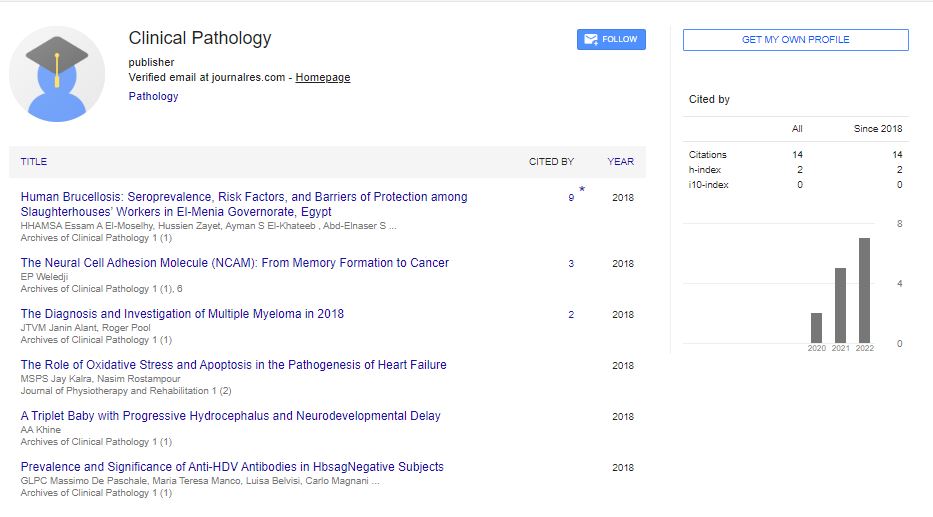Opinion Article, Arch Clin Pathol Vol: 6 Issue: 4
Neuropathology: Navigating the Complexities of Nervous System Disorders
David Williams*
1Department of Pathology, University of Utah, Salt Lake City, USA
*Corresponding Author: David Williams,
Department of Pathology, University of
Utah, Salt Lake City, USA
E-mail: davidwilliams@gmail.com
Received date: 27 November, 2023, Manuscript No. ACPY-24-124239;
Editor assigned date: 29 November, 2023, PreQC No. ACPY-24-124239 (PQ);
Reviewed date: 13 December, 2023, QC No. ACPY-24-124239;
Revised date: 21 December, 2023, Manuscript No. ACPY-24-124239 (R);
Published date: 29 December, 2023 DOI: 10.4172/acpy.100103
Citation: Williams D (2023) Neuropathology: Navigating the Complexities of Nervous System Disorders. Arch Clin Pathol 6:4.
Description
Neuropathology is a specialized branch of pathology dedicated to the study, diagnosis, and understanding of diseases affecting the nervous system. This intricate field delves into the examination of tissues obtained from the brain, spinal cord, nerves, and muscles to elucidate the underlying pathological changes contributing to neurological disorders.
Fundamentals of neuropathology
Neuropathology investigates diseases affecting the Central Nervous System (CNS) and Peripheral Nervous System (PNS), encompassing a diverse spectrum of conditions. The CNS comprises the brain and spinal cord, while the PNS includes nerves extending beyond the CNS. Neuropathologists analyze structural and cellular changes, emphasizing the correlation between pathological findings and clinical manifestations.
Histopathological examination involves the analysis of brain and spinal cord tissues to identify abnormalities such as neuronal loss, gliosis (reactive changes in glial cells), demyelination, and the presence of abnormal protein aggregates (e.g., amyloid plaques, neurofibrillary tangles). Understanding these pathological changes is crucial for diagnosing neurological diseases, including neurodegenerative disorders, infections, tumors, and demyelinating diseases.
Methodologies in neuropathology
Diagnostic approaches in neuropathology involve various techniques to examine nervous system tissues. Histological staining techniques, including Hematoxylin and Eosin (H&E), Luxol fast blue, and silver stains, highlight cellular structures, myelin, and pathological features.
Immunohistochemistry, utilizing specific antibodies, aids in identifying abnormal proteins or antigens within nervous system tissues. This technique assists in diagnosing brain tumors, detecting inflammatory markers, and characterizing protein aggregates associated with neurodegenerative diseases like Alzheimer's or Parkinson's.
Role in disease diagnosis and management
Neuropathology plays a pivotal role in diagnosing and understanding various neurological disorders. Alzheimer's disease, characterized by the accumulation of amyloid plaques and neurofibrillary tangles, requires neuropathological examination for definitive diagnosis. Similarly, in multiple sclerosis, demyelinating lesions observed through neuropathological examination aid in confirming the diagnosis.
Additionally, neuropathology contributes to diagnosing brain tumors, such as gliomas or meningiomas, by assessing cellular morphology, proliferation indices, and genetic alterations. Accurate diagnosis guides clinicians in determining treatment strategies, prognosis, and patient care.
Emerging trends and innovations
Technological advancements continue to shape the landscape of neuropathology. Molecular pathology techniques, such as Next- Generation Sequencing (NGS) and genomic profiling, provide insights into genetic alterations associated with neurological diseases. These molecular analyses aid in tumor classification, predicting treatment responses, and identifying targeted therapies.
Imaging techniques like Positron Emission Tomography (PET) and Magnetic Resonance Imaging (MRI) complement neuropathological evaluations by providing in vivo information about brain structure and function. These imaging modalities assist in correlating imaging findings with pathological changes observed postmortem.
Challenges and future directions
Neuropathology faces challenges such as limited access to postmortem tissue samples, interpreting complex findings, and standardizing diagnostic criteria across institutions. The shortage of neuropathologists and the need for continuous education in emerging diagnostic technologies pose ongoing challenges.
The future of neuropathology involves leveraging Artificial Intelligence (AI) for image analysis and pattern recognition to improve diagnostic accuracy. Collaborations among neuropathologists, neurologists, neuroscientists, and computational experts are essential to address these challenges and advance disease understanding.
Conclusion
Neuropathology stands as a critical discipline in unraveling the complexities of neurological diseases. Its methodologies, ranging from histopathological examination to advanced molecular analyses, continue to drive advancements in diagnostics, treatments, and research in neurology. With ongoing technological innovations and interdisciplinary collaborations, neuropathology enhances precision medicine approaches and improving patient outcomes in the dynamic landscape of neurological healthcare.
 Spanish
Spanish  Chinese
Chinese  Russian
Russian  German
German  French
French  Japanese
Japanese  Portuguese
Portuguese  Hindi
Hindi 